Lifestyle
In 1948 the first Slovenian feature film with sound, titled On Our Own Land (Na svoji zemlji), was released in Union Cinema (Kino Union) in Ljubljana. The film, directed by France Štiglic, was nominated for a Palme d’Or at the 1949 Cannes Film Festival.
The first film ever made in today’s Slovenia was a two-minute long portrait of Ljubljana, filmed from Ljubljana Castle in autumn 1898. The film, which has unfortunately been lost, was then shown in Tivoli Park for about a week in May, 1899.
In 1905 three short films were made about the life in Ljutomer and in 1909 Ljubljana, a seven-minute film depicting Slavec Worker’s Choir’s 25th anniversary celebrations was created and can still be seen today.
In the years 1931 and 1932 two feature silent films celebrating mountaineering were made, that is In the Kingdom of the Goldhorn (V kraljestvu Zlatoroga), which is also the first Slovenian feature film, and The Slopes of Mount Triglav (Triglavske strmine).
After these nothing else was filmed for about a decade, as if the only thing Slovenians needed at the time was to put Triglav on film.
In 1941, just before WWII reached Slovenia, O Vrba was made, a documentary film that shows the house of the Slovenian poet France Prešeren when it was opened as a museum, an event that happened on the same day the film’s creators found out about the German invasion of Poland. The film’s release, however, had to wait until 1945, due to cultural silence imposed by the occupying forces during the war.
Another film was also released in 1945, the first post-war film and documentary with some acted scenes inserted, titled Ljubljana Welcomes Liberators (Ljubljana pozdravlja osvoboditelje).
In 1948, however, Slovenia finally got its first proper feature movie with sound. On One’s Own’s Land was based on the novel Grandpa Orel (Očka Orel) by Ciril Kosmač, and depicts partisan resistance during the last two years of WWII in the Slovenian Littoral, occupied by the Italians, then after capitulation of Italy when it was occupied by the Germans.
The film was the first produced by the company Triglav Film, established in 1946.
You can watch it below, although it’s only available online with Croatian subtitles.
STA, 21 November 2019 - Reading habits in Slovenia have practically not changed since 1973, when the first study into reading was carried out, a publishing industry expert has told the STA, presenting this year's research into reading habits and book purchases in the country.
Miha Kovač, long-serving head of the Publishers' Academy segment at the annual Slovenian Book Fair, says the study, carried out this summer and published in the book headlined The Book and Readers VI, shows three interesting trends.
"The number of non-readers is practically the same as in 1973, meaning that reading habits have practically not changed in more than 40 years."
The number of readers rose by a few percent when Slovenia was amid efforts to gain independence, but then fell again, he says.
Then, compared to 2014, the number of regular readers - those who read more than 10 books a year - dropped by five points to 13% in 2018, three times less than in Norway.
In the same period, the number of those who read weekly dropped from 44% to 38%, with the number of those who read a few times a month or even less rising from 25% to 30%.
"All this shows that reading is not very high on the agenda of our country," Kovač comments on the main trends from the study, which was based on a survey of over 1,000 people aged 18 to 75.
Another interesting trend is that the number of young people reading in English is rising, with as many as 86% of the younger generation preferring to read in English.
While he welcomes the trend from the aspect of bilinguality and cognitive skills, Kovač says it can become a problem if English starts to undermine the mother tongue.
He also says a trend that Slovenian readers buy world best-sellers in English online instead of waiting for the Slovenian translation has gained traction over the past decade.
"Earlier, a Slovenian publisher could publish a translation with a year-long delay, but this did not reflect in the sales.
"Some readers have apparently become so much accustomed to buying and reading in English that it actually presents competition to books published in Slovenian."
The study compares Slovenia with Norway. Kovač says this is because both started researching reading habits almost simultaneously and because Norway fares much better than Slovenia in this respect.
"A Norwegian buys an average ten books a year as opposed to two bought by a Slovenian, which however means that at least theoretically the Slovenian market can still grow."
The number of readers in Norway has increased by 20 percentage points to around 90% since 1979. "Practically everyone is reading there. Based on this, I dare say we have wasted over 40 years of culture and education policies."
Asked what Slovenians could learn from Norwegians, Kovač says that at least 80% of Norwegian parents read to their children as opposed to only 30% in Slovenia, while there are also differences in the educational systems, with the teacher profession being much more prestigious there than in Slovenia.
"So I think we should launch a thorough debate on how to make reading a family value and what to do at school to better develop reading habits," he says.
He admits this is a very long process, regretting that such long-term thinking is not exactly an asset of Slovenian politicians or other decision-makers.
A third set of changes would have to be taken to encourage the publishing industry, he believe.
"But even this will be of little help if reading does not become part of the personal identity of the majority of people."
STA, 20 November 2019 - Previously unknown photos of Melania Trump have been published in a book in Slovenia that sheds light on the US first lady's early modelling career.
First Lady Melania Trump - As She Once Was, brings a series of photos taken in 1991 and 1992, when she was 21 and 22 years of age and already a budding fashion model.
The 13 photos released for the first time are by fashion scout Nino Mihalek, who ran into Melania in the centre of Ljubljana in 1991 and then spent several hours photographing her, according to the book's author Igor Omerza.
Ljubljana: 25 Things to Know about Slovenia's Green City of Dragons
A second photo series in the book are screenshots from a one-minute video taken in 1992 at a beauty pageant in the coastal city of Portorož.
The 80-page paperback, which features Melania's photos interspersed with biographical notes and more or less random photographs of places of interest in Slovenia, is now on sale in Slovenia.
An abbreviated version has been translated into English, but Omerza said he is yet to find a publisher.
More of the images © Nino Mihalek and hosted by Delo can be seen here: one, two, three, four - while all our stories on Melania Trump are here
STA, 19 November 2019 - Overworked and underpaid, Slovenian nurses have been quitting their jobs in droves, leaving hospitals struggling to find replacements, in particular for vacancies at intensive care units.
The situation is worst at UKC Ljubljana, Slovenia's largest hospital, which has been forced to limit admission of patients at about 40 out of 2,150 beds.
"Part of the daily working programme is maintained by going the extra mile to stretch the timetables," UKC Ljubljana said, adding that it lacked the leverage to pay nurses at clinical departments properly.
"Those are the hardest workstations, and younger generations are avoiding them," said UKC Ljubljana director-general Janez Poklukar.
Nurses have been leaving hospitals, where they often work three shifts, for better paid and less demanding jobs either abroad, in primary care or for non-nursing jobs in the corporate sector.
Hospitals in the north and north-east of the country have been hit particularly hard by staff leaving abroad, mainly to Austria. UKC Maribor is facing a shortage of 25% of nursing staff.
Marjan Pintar, the head of the Slovenian Health Institutes' Association, says that staffing problems first occurred with the establishment of nurse-led consultancies at community health centres in 2011.
Some 500 graduate nurses left hospitals for those consultancies at the time, and a further 200 have left to be employed at the call centres established recently, Pintar said.
This is why the shortfall of graduate nurses is the most acute, even though their per capita number in Slovenia is within the OECD average.
"Since 2000 the number of nursing staff increased by 45%, the shortfall mainly due to the gap between the increasing expectations of the profession and the available staff," said Pintar.
"If new work standards are adopted and community health centres need to hire extra graduate nurses, the most demanding units at Slovenian hospitals will be drained empty, which may seriously jeopardise our health system."
Based on the standards that are being drawn up, it is estimated public health institutions will need an additional 3,543 graduate nurses, 145 graduate midwives and 45 nurses with secondary education, at the cost of EUR 100 million.
The nursing and social care trade union estimates shortages at between 20% and 25% at the moment, which means roughly 2,100 nurses, mainly at hospitals. There are also shortages at nursing homes.
What is more, 8,200 nurses are aged above 50. "Over the next few years a large and highly experienced generation of nurses will retire, and it will be impossible to replace," the union's head Dragica Kekec has warned.
"Nursing work is hard ... it involves sacrifice from individuals and families, night-time work ... work at Sundays, holidays, no time to rest, those absent are not being replaced," says Kekec.
Even though 1,000 nurses were registered as unemployed in September, the Employment Service says that less than half had nursing experience and only 580 were looking for a nursing job.
Another problem is that the job seekers do not have the level of education required by the employer, while some of the unemployed have limiting factors such as heath or other issues.
The trade union believes that higher pay and better working conditions would do much to curb the high turnover. It opposes ideas to look for nurses abroad.
Despite shortages, few hospitals have opted for such a solution, the main obstacle being the required language skills and demanding procedures to recognise foreign qualifications.
UKC Ljubljana officials have taken part in a career fair in Belgrade, detecting considerable demand for work in Slovenia. But they note the obstacle of the high language proficiency requirements.
As a stop-gap measures they are hiring staff through student work agencies and alleviating nursing staff of administrative work.
All our stories on healthcare in Slovenia are here
One of most recognizable buildings in Maribor stands at Glavni trg 1 (Main Square No. 1), where the centre of Maribor’s social life was hosted for most of the 20th century.
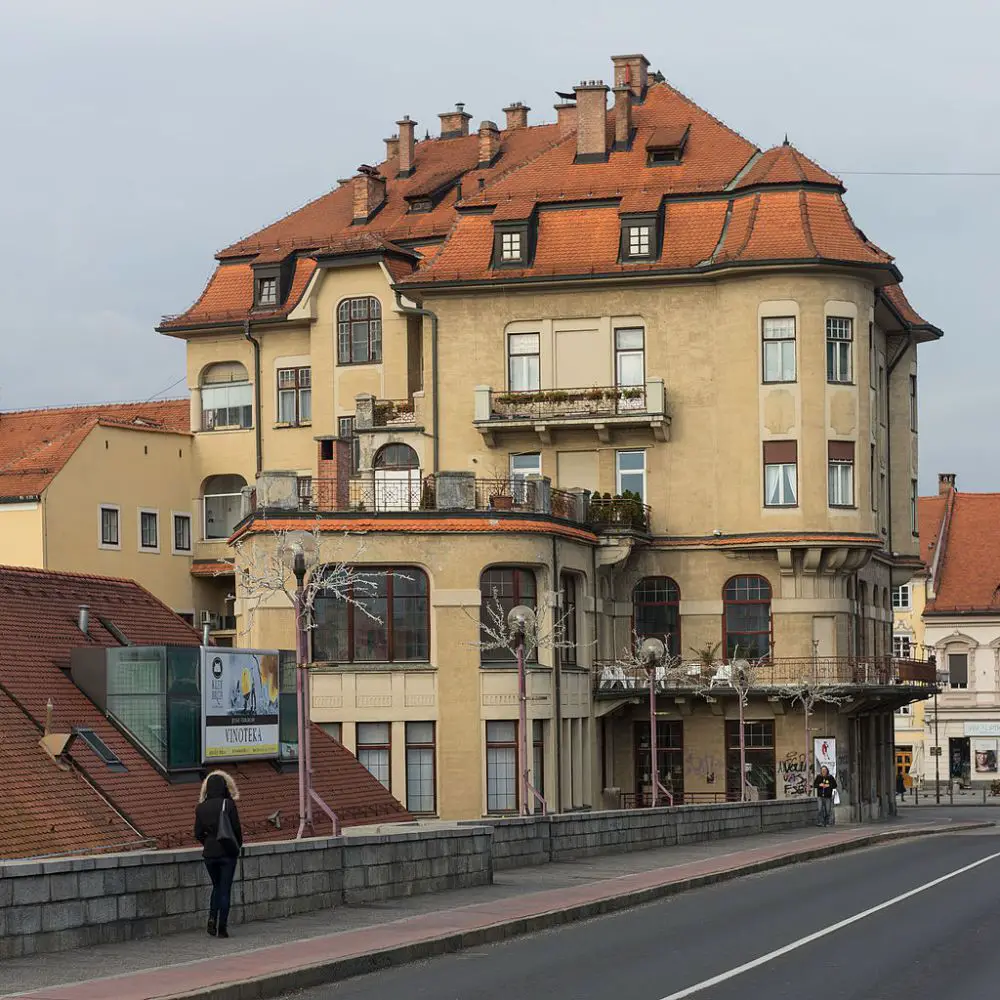
The story of the building is closely related to the nearby bridge, now called the Old Bridge. It was built by a German man Ludwig Franz, who had amassed significant wealth by manufacturing pasta, and decided to bring some advanced urban spirit into the city by building a well-equipped up-to-date house at one end of the new bridge which was being constructed.
The completion of the building occurred one month after the opening of the bridge, which was on August 23, 1913. With his brother Ludwig dedicated the house to their mother and named it Cafe Teresienhof (Theresa’s Court Café).
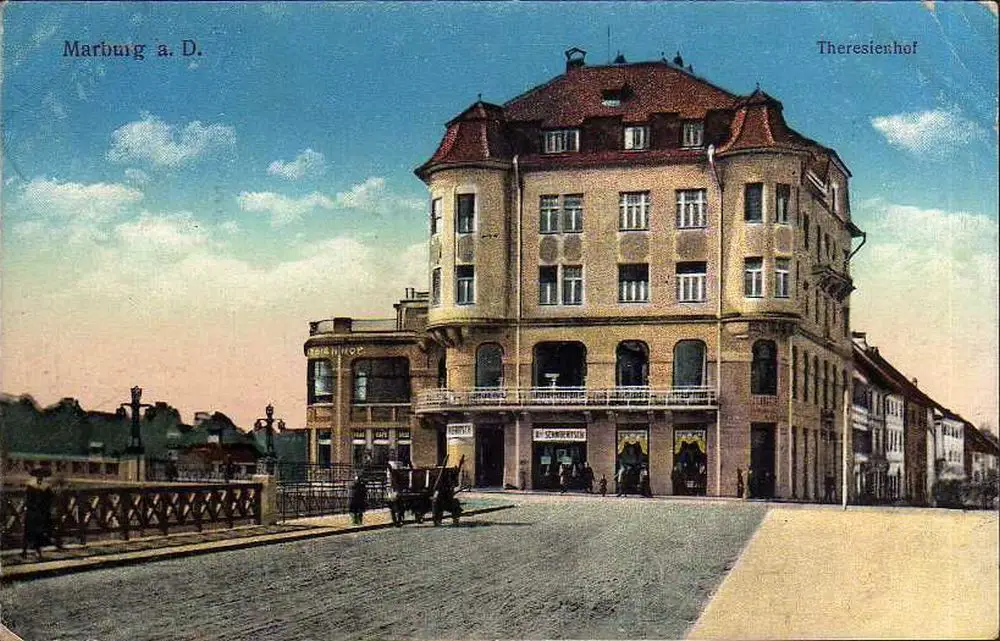
The house was quite advanced for the time, having its own electricity generator, while the café’s services included the possibility of ordering a lunch at the City Square, where it was then delivered by a carriage.
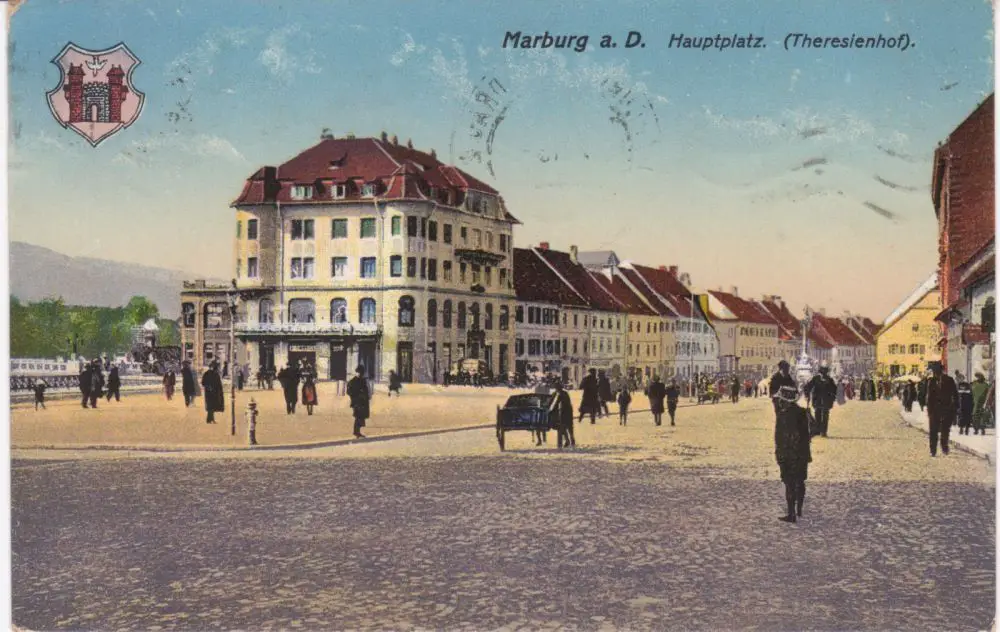
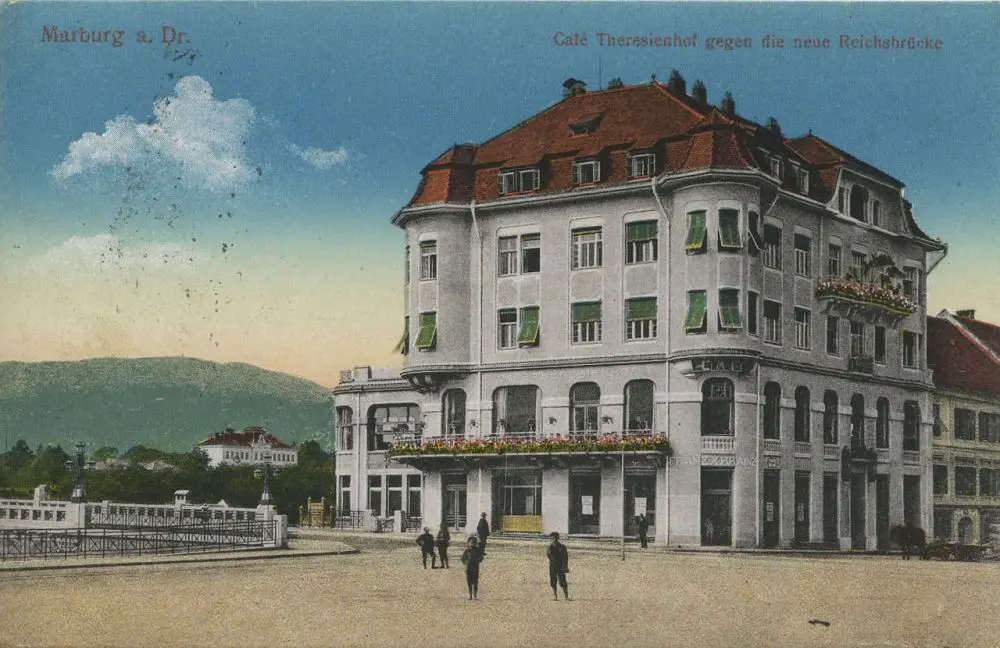
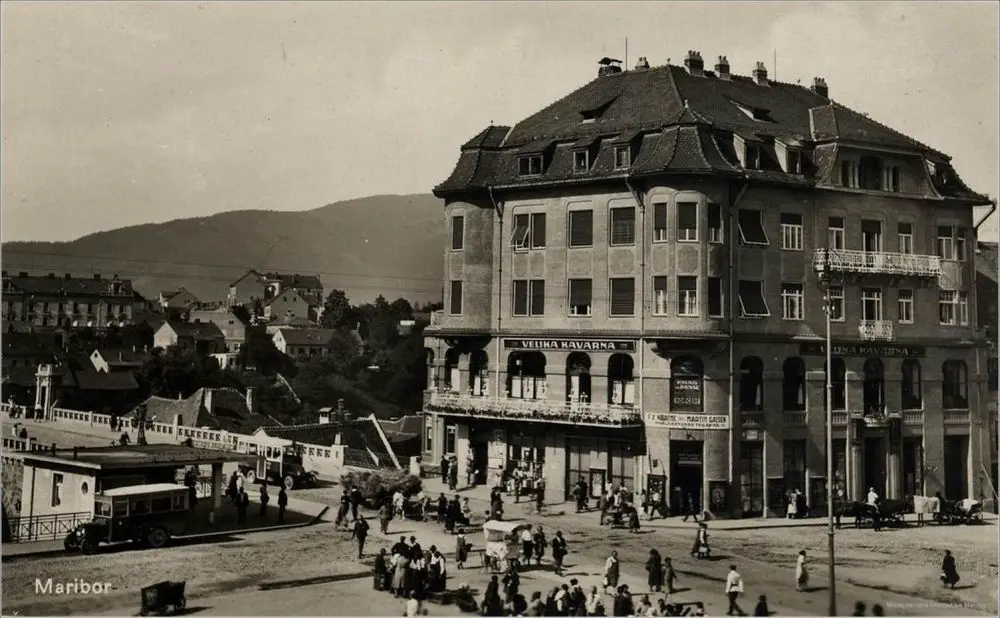
When Adolf Hitler paraded across the main square in 1941, the house was already called Velika Kavarna (Grand Café).
In the fifties and sixties Velika Kavarna was a venue of many pleasant social events for the citizens of Maribor, with many later stars in the Slovenian popular music scene beginning their careers there.
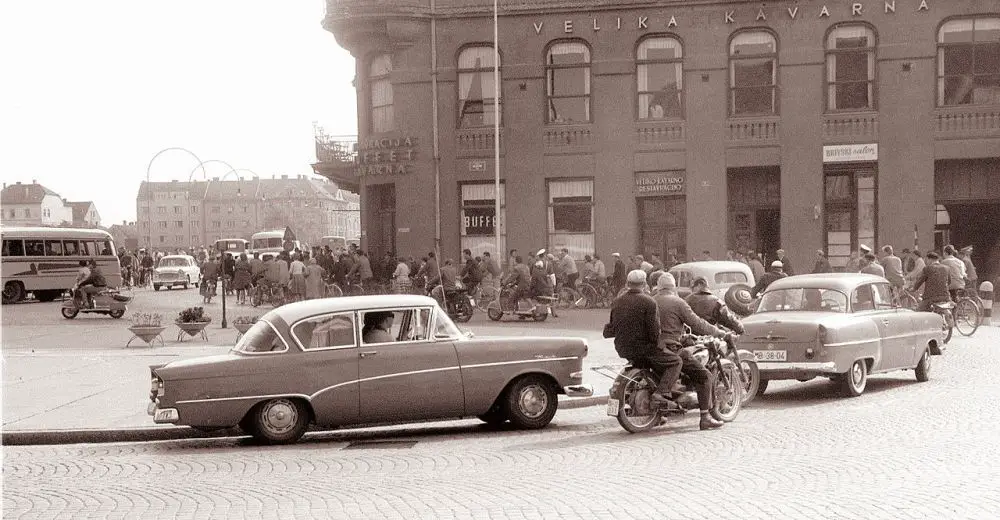
Following this golden age of the Velika Kavarna, a casino came into the building, which went bankrupt in 2009 and left the old café’s salon in not so splendid condition. Apparently, the casino’s management, having no money at hand to pay staff their deserved salaries, decided they could just take with anything valuable they could find on the premises. This is how Velika Kavarna was stripped of its lights and chandeliers.
Years of negotiations and fights over ownership ensued, all slowly inscribing themselves into the walls of the building, until the Grand Café was finally reopened as the Salon of Applied Arts, which decided to preserve the entire history of the place on the walls and equipment and turn the café back into a hangout for everyone curious about history of the house and local design.
Unfortunately, Salon of applied arts closed its doors permanently in July 2019. We wonder what will happen next.
Slovenia may be the only country in the world with “love” in its name, but romance is perhaps not on the menu after dark on 29 and 30 November when Celje hosts Eroticland – the biggest European regional erotic festival, and one operating under a new name after a decade as SLOVErotica.
On that weekend, the last Friday and Saturday nights in November, the city of counts will play host to the legendary Rocco Siffredi, director and star of some 1,300 adult films, along with other names from the world of pornography (including Veronica Avluv, Martina Smeraldi, Cherry Kiss, Christiana Cinn, Michael Stefano, Laura Fiorentino, Franco Roccaforte, Mike Angelo, Angel Emily, Amandha Fox and Lisa Amane, see here, NSFW). On both days the event runs from 18:00 to 02:00, and has a programme, see here (NSFW), that promises six stages offering an erotic car wash, a freeky (sic) zone with some bondage and rope, dancing in cages and on poles, erotic workshops, a ladies zone, a swingers’ corner, tantric experiences, exhibitors stalls and more.
The focal attraction will be an orgy organised by the “Italian Stallion”, and in the words of the official website:
Rocco Siffredi’s HARD ACADEMY SPACE VERSION ORCHESTRA will be one of the most striking performances of this year’s Eroticland! An “orchestra” orgy live, under the watchful eye of “conductor” Rocco, who simultaneously elevates and communicates with the audience… There will be a battle between MILFs as violas and the newcomers as the violins, while the men will be the brass section, checking out who does it better! Seen for the first time at and created only for EROTICLAND!
The publicity for the event, which is strictly 18+, goes on to note “We are certain that this extraordinary event will leave a lasting impression on you and create scenes you won’t forget easily!”
Eroticland will be held at Celjski sejem, Dečkova cesta 1 3000 Celje, tickets can be purchased here (NSFW), and please note that animals are strictly forbidden.
In 1896 a four-kilometre long electric grid with 700 light bulbs came into operation in Kočevje, the event marking the beginning of the public distribution and supply of electricity in Slovenia.
The historical use of electricity in Slovenia begins in Maribor, where the first electric light illuminated the steam mill in 1883. The beginning of electrification, however, is considered the year 1894, when the first public hydroelectric plant began operating on Sora River in Škofja Loka.
The main purpose of the hydroelectric plant in Škofja Loka, however, was not to provide electricity for public use but rather for the needs of a thread factory, which was also the producer of the energy it needed. The surplus of electricity was sold to the city government and could support about 40 electric bulbs.
The hydro power plant in Kočevje, which was established to deliver water and electricity to the citizens, beginning on today’s date in 1896, is therefore considered as the beginning of electrification of today’s Slovenia.
In comparison, in Ljubljana the first electric bulb did not get turned on until January 1, 1898.
The Ljubljana LGBT Film Festival is back for its 35th edition, officially starting Saturday, 23 November, and with events planned for Ptuj, Koper, Maribor, Bistrica ob Sotli, Idrija and Trst (aka Trieste, if you must), although the fun has already been going for more than week.
First put on back in 1984 as part of the Magnus Festival – back in the days of mystery VHS tapes showing films recorded from Britain’s Channel 4 to audiences who had no idea what was coming next – it’s the oldest LGBT film festival in Europe, as well as the oldest international film festival in Slovenia. As such it’s a valued part of the country’s cultural calendar, and a nice way to welcome in the festive season.
The list of films show include the following, and note that English and Slovenian subtitles will provided when needed
Film and video are the focus, but the programme has much more to offer, with panel discussions, readings, parties and so on. While the formal opening is 23 November, with an cocktail party hosted by Lady Galore at Kinoteka and then moving to Klub K4, the events have already begun and will continue until Sunday 1 December, World Aids Day.
Organised by ŠKUC and the Kinoteka (the Slovenian Cinemateque), along with Brane Mozetič, Jasmina Šepetavc, Luka Pieri, Miha Satler, Polona Černič, Simona Jerala and Suzana Tratnik, full details of the LGBT Film Festival programme can be found here, and there are also Facebook and Instagram pages.
All our stories with an LGBT focus are here
In 1918, following the end of WWI, the Serbian army officer Stevan Šabić and some of the Serbian army troops that have been captured by Austro-Hungarians during the war made a stop in Ljubljana on their way to Serbia and prevented its plunder by retreating military gangs and its planned occupation by the advancing Italian forces. Lieutenant Colonel Švabić, having the highest rank in the land he found himself in, also prevented the capture and plunder of Trbovlje and some other Slovenian towns.
In the chaos that followed the end of the WWI the newly established State of Serbs Croats and Slovenes (a month later the state embraced the Serbian king becoming a Kingdom itself) was not yet recognised and did not have its own army presence in all of the territories it claimed, especially in Slovenia, which used to be part of the now defeated Austrian Empire. With no troops present, the land was open for post-war looting, violence and changing of geopolitical circumstances which could potentially affect the new border agreements which were soon to follow.
Post-war Hungarian military violence against the Slovenian majority population in Prekmurje ended with the Paris Peace Conference in 1919, where Hungary was forced to sign the Treaty of Trianon, which granted people the right to self-determination and allowed Prekmurje to join the Kingdom of SCS.
In Maribor, where on October 30, 1918 the German city council declared lower Styria (Štajerska) as part of the Austrian territory, General Rudolf Maister, who managed to mobilise 3,000 troops, disarmed the German guard on November 23, then continued a military campaign for Slovenian Styria and Carinthia.
On the Western border, however, things were a bit more complicated. The “people’s self-determination” principle that guided the Treaty of Trianon of the Paris Peace Conference was forgotten here in favour of the secret 1915 Treaty of London, which promised Italy large territorial gains in case of the Entente Powers’ victory. The controversial treaty became public after Lenin publicly denounced it in 1917.
Nevertheless, about 1/3 of the lands where Slovenians lived went to Italy, including the entire Southern and Northern littoral right up to the peak of Triglav. And in the post-war chaos with the central part of the country undefended, Italians turned their eyes on the capital, Ljubljana, as well.
On November 6, 1918, a Lieutenant Colonel of the Serbian army, Stevan Švabić, and other Serbian prisoners of war made a stop in Ljubljana after being released from Austrian war camps. According to Švabić’s account, Ljubljana train station was in a complete disorder: there was a train with 15 cars full of armed Hungarians on a nearby track and several other trains with armed militias present at the station. Immediately after his arrival at the station he was already being looked for by Adolf Ravnikar, sent to find help by the city authorities. Ravnikar explained the situation as alarming: out of control Austrian soldiers were returning from the front, while the Italian army followed them. If immediate help was not found, gangs would ransack the city and empty the military depots.
Understanding the urgency, Švabić gathered his troops to restore some basic order in the city, while prepared to address the problem of the advancing Italian army which had by November 10 already reached Logatec and was heading towards Vrhnika.
By November 14, Švabič had about 2,000 men and probably got a permission from Zagreb, to send the Italian commanding officer in Vrhnika an ultimatum not to continue the advance of the Italian troops further to Ljubljana, as he would have find “use of weapons on allied forces most regretful”.
The ultimatum, which was based on a pretext that the allied forces, the Serbs, had already taken control of the surrendered Austrian territories, stirred a lot of confusion on the Italian side, which must have concluded that perhaps the Serbian army had indeed managed to reach that far north at such a short notice. Furthermore, additional pressure on the Italians to retreat came from the French, who were called to do so by the Serbs.
In the days that followed, the Italian army retreated from Vrhnika while only six days after his ultimatum Stevan Švabić was called to Belgrade, probably due to a presumed violation of the chain of command by signing his name on the document which threatened an allied country with the use of weapons.
In 1930 Stevan Švabić was awarded a deserving citizen medal by the City of Ljubljana and two streets in Slovenia are named after him: Švabićeva ulica in Trnovo, Ljubljana and Švabićeva ulica in Vrhnika.
STA, 17 November 2019 - Some 46% of 20-24-year-olds in Slovenia are students, which is the highest share among EU countries, according to the Statistics Office. Slovenia had almost 76,000 students in the 2018/19 academic year, mostly women. More than half of all students enrolled in the first cycle graduate successfully, the statistics show.
In terms of the share of students among people aged between 20 and 24, Slovenia is followed in the EU by Greece (44%) and Poland (40%), the Statistics Office said ahead of World Students' Day, 17 November.
Slovenia Attracting Growing Number of Foreign Students
There are more women studying in Slovenia than men, and the share of women is also higher in most fields of tertiary education - pedagogy, health, social security, humanities, art, social sciences, information sciences, business and administrative studies, law, agronomy, veterinary studies, natural sciences, mathematics and hospitality and tourism.
Male students predominate only in technical studies, construction and ICT.
Some 60% of women and 42% of men enrolled in the first cycle of tertiary studies in 2010/11 finished their studies.
According to the Statistics Office, young people whose parents have tertiary education are more likely to enrol in tertiary education. In 2017/18, 71% of 19-24-year-olds with at least one parent who finished at least tertiary education enrolled in tertiary education.
All our stories about studying in Slovenia are here, while more statistics are here, and the SURS report for International Students Day, 2019, is below
STA, 14 November - The 26th Biennial of Design (BIO 26) opened in Ljubljana on Thursday. Running until 9 February under the title Common Knowledge, it will explore the information crisis and the struggles of traditional bearers of truth.
Elaborating on the concept of BIO 26 for the STA, its curator Thomas Geisler said design, in particular graphic design, had always had the task of translating information and knowledge or visualising complex content.
Geisler added design was less product-oriented than it used to be, having instead developed more systematic approaches. The history of the Ljubljana biennial is a case in point. What used to be an exhibition of well-designed products has evolved into an experimental platform for new approaches in design that seem more relevant today.
The organisers of BIO 26 have identified the inflation and chaos in the field of information as a key challenge in society, with science, academia, the media and journalism struggling to preserve their Enlightenment status as the four pillars of truth.
The notion of common knowledge relates and refers to what people know; more broadly, if refers to what people think and how they structure their ideas, feelings, and beliefs.
Furthermore, the term common knowledge carries a sense of communal or shared knowledge, with Geisler stressing the need to make access to knowledge not a privilege but something accessible as widely as possible.
BIO 26 will feature a curated exhibition at the Museum of Architecture and Design (Muzej za arhitekturo in oblikovanje - MAO), which Geisler said would provide insight into how and where design can be active in the field of information and communication.
The opening section of the show will present the information crisis, while the hierarchical model of information, starting with data and ending with wisdom, will be outlined later on.
The festival will moreover present six winning projects selected through the Designathon, in which groups of designers and non-designers took on in recent months the challenges pressing on the institutions of knowledge production and knowledge transmission.
Geisler pointed out that traditional institutions, for instance the National University Library, which is build on concepts from the 19th century, are struggling as a result of social changes and digitalisation. Unlike in the 19th century, interaction is the primary mode of information sharing today; the library's users would share knowledge, but the architecture in itself prevents this.
Traditional institutions of knowledge are also very slow to change and the projects started as part of BIO 26 sough to identify ways to adapt to the new challenges.
"This is actually the most we can do. We cannot serve them detailed answers and of course also cannot solve their problems," said the Austrian curator, who is assisted by curator and journalist Aline Lara Rezende.
Along with the library, BIO 26 has also involved the Museum of Contemporary Art Metelkova, the University of Ljubljana, publisher Delo, as well as an elderly home and the Ljubljana Botanical Gardens.
Geisler pointed out that the transmission of knowledge from older people was a tradition that had already disappeared decades ago, while the Anthropocene epoch had also completely divorced humankind from nature, leaving people without even basic knowledge about it.
The projects will be presented at the participating institutions. Pointing out that probably not many of Delo's readers had ever entered the publisher's premises, Geisler said that the idea was getting people to go to these institutions.
He sees the installations as prototypes that will allow the institutions to also get some feedback and use it all in future projects.
You can see the full programme here, while you can see what else is on in Ljubljana this week here





